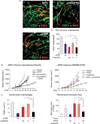Drug delivery strategies for therapeutic angiogenesis and antiangiogenesis
- PMID: 21338327
- PMCID: PMC3959173
- DOI: 10.1517/17425247.2011.558082
Drug delivery strategies for therapeutic angiogenesis and antiangiogenesis
Abstract
Introduction: Angiogenesis is essential to human biology and of great clinical significance. Excessive or reduced angiogenesis can result in, or exacerbate, several disease states, including tumor formation, exudative age-related macular degeneration (AMD) and ischemia. Innovative drug delivery systems can increase the effectiveness of therapies used to treat angiogenesis-related diseases.
Areas covered: This paper reviews the basic biology of angiogenesis, including current knowledge about its disruption in diseases, with the focus on cancer and AMD. Anti- and proangiogenic drugs available for clinical use or in development are also discussed, as well as experimental drug delivery systems that can potentially improve these therapies to enhance or reduce angiogenesis in a more controlled manner.
Expert opinion: Laboratory and clinical results have shown pro- or antiangiogenic drug delivery strategies to be effective in drastically slowing disease progression. Further research in this area will increase the efficacy, specificity and duration of these therapies. Future directions with composite drug delivery systems may make possible targeting of multiple factors for synergistic effects.
Conflict of interest statement
The authors declare no conflict of interest.
Figures





Similar articles
-
Is angiogenesis an organizing principle in biology and medicine?J Pediatr Surg. 2007 Jan;42(1):1-11. doi: 10.1016/j.jpedsurg.2006.09.048. J Pediatr Surg. 2007. PMID: 17208533 No abstract available.
-
Editorial: Angiogenesis agents.Curr Pharm Des. 2007;13(35):3543-4. doi: 10.2174/138161207782794112. Curr Pharm Des. 2007. PMID: 18220790 No abstract available.
-
Diverse effects of statins on angiogenesis: new therapeutic avenues.Pharmacotherapy. 2010 Feb;30(2):169-76. doi: 10.1592/phco.30.2.169. Pharmacotherapy. 2010. PMID: 20099991 Review.
-
Phase II angiogenesis stimulators.Expert Opin Investig Drugs. 2013 Sep;22(9):1157-66. doi: 10.1517/13543784.2013.813933. Epub 2013 Jun 22. Expert Opin Investig Drugs. 2013. PMID: 23790062 Review.
-
Therapeutic targeting of angiogenesis molecular pathways in angiogenesis-dependent diseases.Biomed Pharmacother. 2019 Feb;110:775-785. doi: 10.1016/j.biopha.2018.12.022. Epub 2018 Dec 13. Biomed Pharmacother. 2019. PMID: 30554116 Review.
Cited by
-
Development of L-Lysine-Loaded PLGA Microparticles as a Controlled Release System for Angiogenesis Enhancement.Pharmaceutics. 2023 Feb 1;15(2):479. doi: 10.3390/pharmaceutics15020479. Pharmaceutics. 2023. PMID: 36839801 Free PMC article.
-
Customizable biomaterials as tools for advanced anti-angiogenic drug discovery.Biomaterials. 2018 Oct;181:53-66. doi: 10.1016/j.biomaterials.2018.07.041. Epub 2018 Jul 26. Biomaterials. 2018. PMID: 30077137 Free PMC article. Review.
-
3D Bioprinting for Vascularized Tissue-Engineered Bone Fabrication.Materials (Basel). 2020 May 15;13(10):2278. doi: 10.3390/ma13102278. Materials (Basel). 2020. PMID: 32429135 Free PMC article. Review.
-
Vascular response patterns to targeted therapies in murine breast cancer models with divergent degrees of malignancy.Breast Cancer Res. 2023 May 23;25(1):56. doi: 10.1186/s13058-023-01658-9. Breast Cancer Res. 2023. PMID: 37221619 Free PMC article.
-
"Therapeutic advancements in nanomedicine: The multifaceted roles of silver nanoparticles".Biotechnol Notes. 2024 Jun 1;5:64-79. doi: 10.1016/j.biotno.2024.05.002. eCollection 2024. Biotechnol Notes. 2024. PMID: 39416696 Free PMC article. Review.
References
-
-
Phelps EA, Garcia AJ. Update on therapeutic vascularization strategies. Regen Med. 2009;4(1):65–80. • This article is a good review on current advances in vascularization strategies used in the fields of tissue engineering and regenerative medicine.
-
-
- Eichmann A, Pardanaud L, Yuan L, et al. Vasculogenesis and the search for the hemangioblast. J Hematotherapy Stem Cell Res. 2002;11(2):207–214. - PubMed
-
- Risau W. Mechanisms of angiogenesis. Nature. 1997;386(6626):671–674. - PubMed
-
- Glotzbach JP, Levi B, Wong VW, et al. The basic science of vascular biology: implications for the practicing surgeon. Plast Reconstr Surg. 2010;126(5):1528–1538. - PubMed
-
- Folkman J. Angiogenesis in psoriasis: therapeutic implications. J Invest Dermatol. 1972;59:40–43. - PubMed
Publication types
MeSH terms
Substances
Grants and funding
LinkOut - more resources
Full Text Sources
Other Literature Sources
